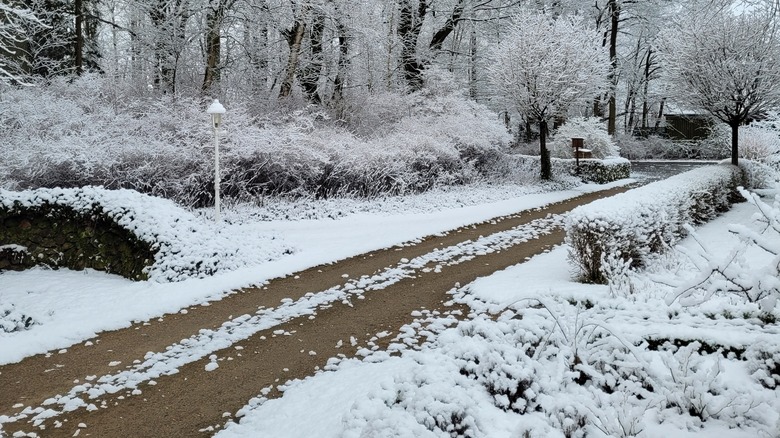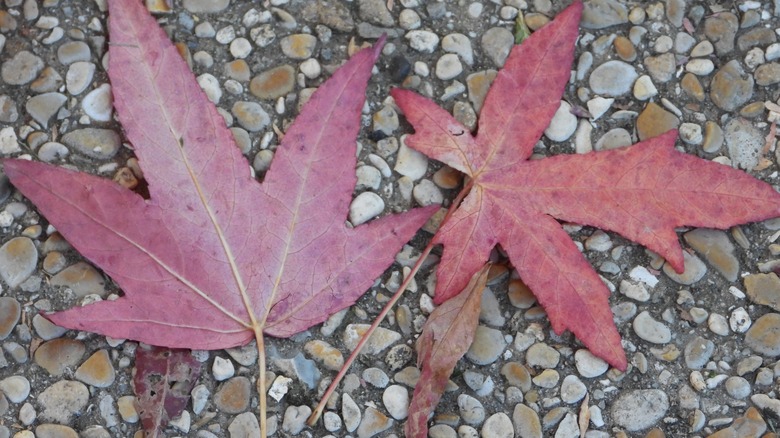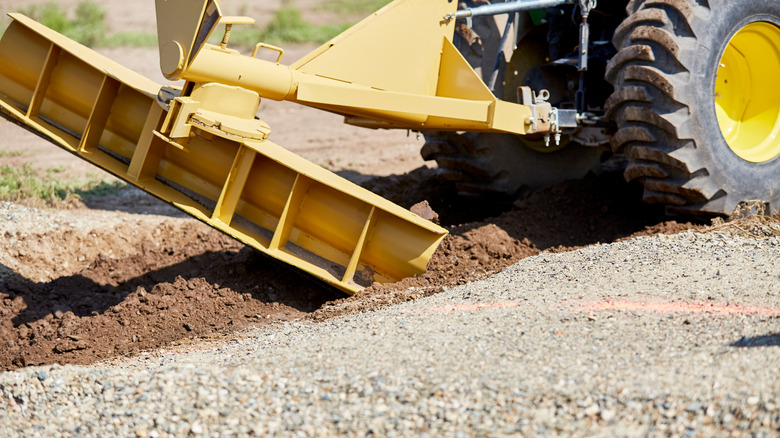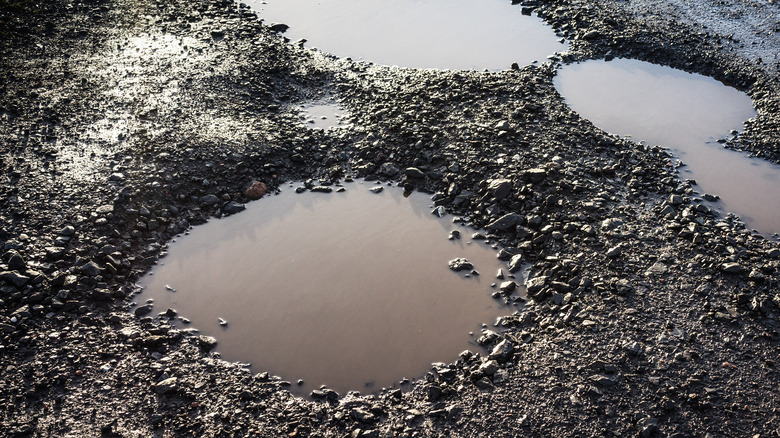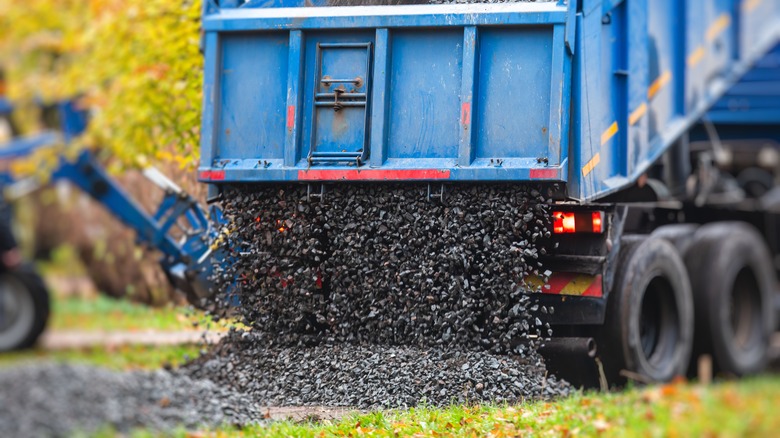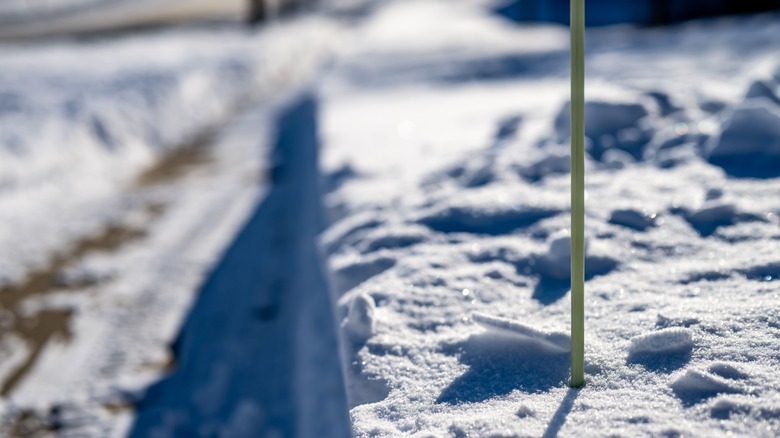5 Must-Do Tasks To Prep Your Gravel Driveway For Winter
We may receive a commission on purchases made from links.
Gravel driveways are great in many ways. For one, they're more cost-effective than their concrete or asphalt counterparts. They're also easier to install and maintain if you're a DIYer. However, one of the drawbacks of gravel driveways is the need for more intensive pre-winter maintenance. Unlike their stronger, smoother concrete and asphalt peers, gravel driveways are prone to washouts, shifting, erosion, and debris getting stuck between the stones. If you don't correct these flaws before winter, you'll be dealing with slipping hazards, uneven surfaces, and even more potholes and runoff as the snow melts in spring.
The good news is that you can enjoy your gravel driveway all winter long just as you do in the warmer months as long as you perform a few must-do tasks to winterize the surface. Crucially, you'll need to rid the driveway of any debris, regrade it as needed, fix potholes and ruts, top the whole thing off with a new layer of stone, and finally, insert some markers along the edges. Some of these tasks are simpler than others, and depending on the state of your driveway going into winter, you may have to rent some heavy equipment or call a professional to help you out. Below, we'll walk you through each of these pre-winter maintenance tasks so you can help your gravel driveway brave the upcoming winter season.
Remove all waste from the gravel driveway
It shouldn't come as a surprise that gravel driveways accumulate more debris than their asphalt or concrete counterparts. After all, the loose stones are far better at trapping various waste, such as leaves, twigs, or garbage than the kind of smooth surface you get with asphalt or concrete. Unfortunately, this debris will pose a major problem when wet, cold winter weather heads your way. That's because these items will allow snow and ice to build up on top of them, leaving you with icy bits scattered around the driveway — and that's not a safe condition for your vehicle. As the temperatures swing up and down, the snow and ice will melt and refreeze, turning the driveway into a slipping hazard for people walking on it, too.
To keep your gravel driveway safe for both vehicular and pedestrian use, you have to get rid of any waste build-up as part of your winter preparation process. The easiest way to go about it is with a powerful leaf-blower, like this Lithium-ion Cordless Leaf Blower from EGO Power+. However, if you have a small-enough driveway, or simply prefer not to use leaf-blowers, a rake will do the job just fine. In fact, regular raking is an important step in maintaining a gravel driveway throughout the year, since it helps to distribute the crushed stone evenly throughout the surface. Doing so at the end of fall comes with the bonus of getting any debris off the driveway, too.
Check whether the driveway needs re-grading
Gravel driveways can suffer a great deal at the hands of rainwater runoff. Since the gravel is loose, rainwater running through the driveway can wash some of the stones away with time; this process is known as a washout. In areas with heavy rainfall, washouts can displace a good portion of the stones, leave bare spots, and even erode the driveway. Water runoff isn't the only force that can damage a crushed stone driveway. The stones can also move around due to temperature changes and during periods of excessive heat and dryness. Regardless of the root cause, a driveway with such a battered surface is likely to contribute to more erosion and runoff, as well as puddling and ruts (grooves made by car tires) when the snow melts the following year. That's why it's crucial to address these faults before winter by checking the evenness of the gravel driveway and regrading it as needed.
How you regrade the driveway depends on the severity of its unevenness. If all you're seeing is a few odd bare spots, then raking over them and adding a bit of gravel on top should suffice. If the issues are more advanced, and significant chunks of the gravel have washed away, or you're seeing major deformations in the surface, you'll need to use a tractor with a box scraper attachment. However, before you turn to heavy machinery for regrading, you'll need to add some gravel to the bottom of any potholes or ruts present on the surface.
Repair potholes and ruts in the driveway
Potholes and ruts in a gravel driveway stem from the same root cause as other grading issues — mainly, rainwater. If the driveway is not graded correctly in the first place, rainwater will pool on its surface and seep beneath the gravel. As it does, it will disturb the substrate and make it soft. Over time, the gravel will sink into these areas of soft, moisture-laden soil. That's how you get potholes. Ruts are created in a similar way, except the softness of the dirt beneath the gravel gets exacerbated by the pressures exerted by vehicles traveling or being parked on the surface. If you're noticing potholes and ruts on your gravel driveway, it's best to repair them before chilly, snowy winter weather — this way, you'll get to use your snowplow on a nice, smooth surface.
You may think that filling a pothole or rut with gravel and compacting it a bit is all that's needed for a quality fix. Alas, that's not the case. The only way to make sure that a pothole doesn't reemerge in the exact same spot is to loosen the surface to the very bottom of the granular layer, before regrading the affected area and compacting it. To do this, you'll need a tractor and a heavy-duty attachment that can loosen the crushed stone well (aim for an attachment with 3 to 5 inch-teeth). Once you regrade the area, you can use your tractor with a compacting attachment to compress the surface. Now, if you just want a quick fix to last the winter, you can rake the gravel around the pothole, add more stone to it, then compact it by hand using a tamper tool or heavy buckets. Again, this is only a temporary fix, but it will help you operate the snow plow without issues for a few months.
Add a new layer of gravel to the driveway
As we discussed above, the forces of nature are just not kind to gravel driveways. Water, the lack of water, cold temperatures, and hot temperatures can displace the stones and leave your surface uneven. When winter blankets your driveway with snow and ice, these uneven patches will be unsafe and difficult to work on if you use a snowplow. That's why an important part of winterizing your gravel driveway is to top it off with some new stone. Crushed limestone is a great new aggregate option, since this type of gravel bonds together well once you compact it — this means that the resurfaced areas are less likely to shift when you drive on them. You can spread the gravel out on the driveway yourself. Just make sure you're adding generous amounts of the aggregate to make a nice, thick new layer, while keeping the surface as even as possible.
Now, if your driveway is in really bad shape, with large parts of it missing stone, you may have to resurface it completely. In this case, you're looking at adding between 2 and 3 inches of new material. Unfortunately, you won't be able to spread the new aggregate by hand. Instead, you'll have to use a tractor with a grading scraper attachment. Once the new gravel is laid down, grade the surface in a way that creates a small ridge running along the center of the driveway apron. This way, rainwater will be able to drain to the edges of the driveway instead of pooling on it and creating potholes.
Insert markers along the edges of the driveway
You don't want to drive that snowplow over the curb that runs along the edge of the driveway, right? Well, if your area gets a good helping of snow, it may be hard to know where the driveway apron meets the curb. This inability to discern the contours of the driveway can be dangerous not just for your snowplow, but also for your car, or any pedestrians making their way to or from your home. Likewise, snow might make it easy to accidentally drive a car or heavy equipment over your lawn or garden beds. To keep yourself, your family, your visitors, your yard, and your equipment safe, it's important to mark the edges of the gravel driveway so that they're easy to recognize even in the snow.
Driveway markers are brightly colored stakes you insert at intervals along the edges of the driveway. For example, these VEVOR driveway markers are painted in a highly visible, orange color and come with reflective tape, so you can see them well when driving at night. They come with a pointed tip that should be easy enough to insert deep into the substrate beneath the gravel surface. If you catch yourself winterizing the driveway after the ground has started to freeze, you should be able to use a drill with a long, threaded bit to create a hole for the markers. Driveway markers come in different heights. When choosing yours, consider how much snow your area can get in a single snowfall event and make sure the markers are tall enough to protrude above the snow banks.
